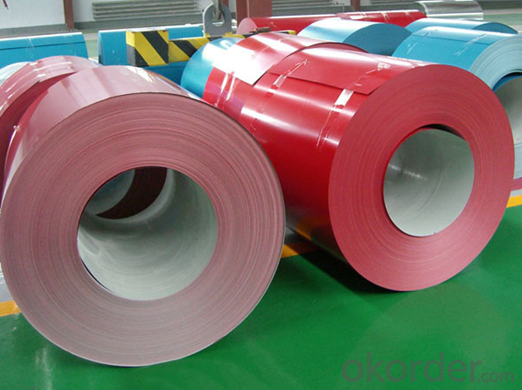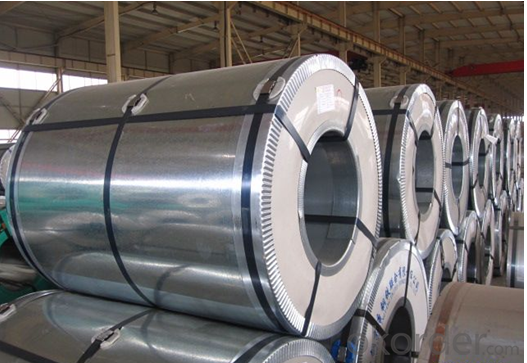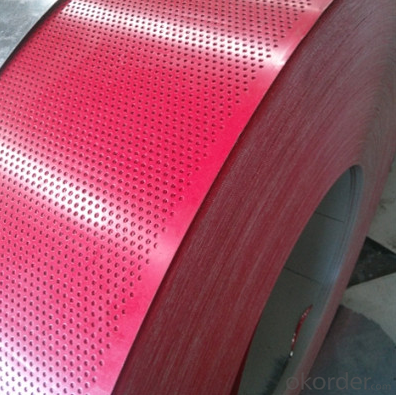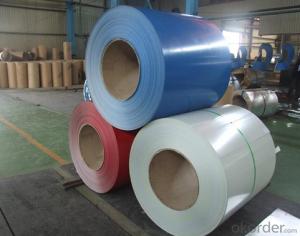Color Coated Galvanized Steel Coil/0.4mm-0.5mm Pre-Painted Galvanized Steel Roofing Sheet PPGI
- Loading Port:
- China main port
- Payment Terms:
- TT OR LC
- Min Order Qty:
- 25 m.t.
- Supply Capability:
- 10000 m.t./month
OKorder Service Pledge
OKorder Financial Service
You Might Also Like
Product Description
Color Coated Galvanized Steel Coil
ISO System
SGS and BV Audited company
Industry experience over 10 years
Management Systems-Internal Software
Finished Product Inventory-More Than 500 Tons
Raw Material inventory -Over 800 Mertic Tons
Shipment of goods -More than 30 countries worldwide
We have the most convenient transport and prompt delivery
We offer competitive price with best service
We have high technical production line with top quality products
We have win high reputation based on best quality products
Product Description
PPGI:
1, Introduction: Color coated steel coils(sheets), i. e. PPGI, also called prepainted steel coils(sheets), are made of galvanized steel coils(sheets) with polymer coatings as surface. It's a new enclosure material and building board with characteristics of light-weighted, heat preserved&insulated, easily installed with bright colors.
2, Production Process: Pretreatment(Degreasing)_Drying_Chromating_Paint Basic Oil_Cooling_Drying_Color Coating_Cooling_Film-covering_Rolling Up
3, Characteristics:
Good at corrosion resistence. Besides zinc coating of the basic plate of galvanized steel sheet, the color coating as the surface has double lifetime to ensure better anticorrosion effect.
with excellent cold bending molded manufacturablity, PPGI products can be processed or directly used as final product. As being light-weighted and conveniently transported, they're widly used to replace wood to save energy.
There're thousands of colors can be chosen as per different application. Any color plays well in decoration.
No pollution with high recycling rate, PPGI coils and sheets are strongly recommended as enviroment-friendly products by the government.
4, Appliance: Thanks to the above characteristics, color coated steel coils and sheets are widly used in construction, furniture industry, transportation industry, ect.
5, eye bands and 4 circumferential bands in steel, galvanized metal fluted rings on inner and outer edges, galvanized.
Type of substrate | Grade of color plate | Standard | Application& feature |
Hot dip galvanized | TDC51D+Z | DC51D+Z | ordinary use |
TDC52D+Z | DC52D+Z | SPCD | |
TDC53D+Z | DC53D+Z | SPCE | |
TS280GD+Z | TS280GD+Z | Structure use | |
TS350GD+Z | TS350GD+Z | Structure use | |
TS550GD+Z | TS550GD+Z | High strength structure use | |
Hot dip galvalume | TDC51D+AZ | DC51D+AZ | ordinary use |
TDC52D+AZ | DC52D+AZ | SPCD | |
TS250GD+AZ | S250GD+AZ | Structure use | |
TS300GD+AZ | 300GD+AZ | Structure use | |
TS350GD+AZ | 350GD+AZ | Structure use | |
TS550GD+AZ | 550GD+AZ | High strength structure use |
Type of coating process | Front:double coated&double drying |
Type of substrate | Hot dip galvanized,galvalume,zinc alloy,cold rolled steel,aluminium |
Coating | Top paint:10-25 micron(Normal 10-12 micron) |
Back paint:5-12 micron(Normal 5-7 micron) | |
ID(mm) | 508/610mm |
Coil weight(ton) | 3-9 ton |
Coating types | Top paint:PVDF,HDP,SMP,PE,PU |
Functions: | Decorative,Machinability,Weather resistance,Scrath resistance,Stain |
Primer paint: | polyurethane,Epoxy,PE |
Back paint: | Epoxy,modified polyester |



FAQ
1.What's your MOQ?
25MT, it is for one container.
2.Do you have QC teams?
Yeah, sure, our QC team is very important, they will keep the quality control for our products.
3.Are the products tested before shipping?
Yes, all of our PPGI and GI was qualified before shipping. We test every batch every day.
4. Is the sample available?
Yes, samples can be sent for test if you need.
- Q:What is steel made of and what is its molecular weight? It's for a project in chemistry class so if you have a website link as well, that would be great!
- Steel is an alloy consisting mostly of iron with a little Carbon thrown in. Steel is not a molecule, therefore, it does not have a molecular weight. Steel contains atoms of iron and carbon in a crystal lattice, along with various other alloying elements such as manganese, chromium, vanadium, and tungsten.
- Q:How are steel coils used in the manufacturing of lighting fixtures?
- Steel coils are used in the manufacturing of lighting fixtures as they provide a sturdy and durable structure for the fixtures. The coils are typically shaped and formed to create the desired shape and design of the lighting fixture, ensuring its strength and stability. Additionally, the steel coils can be coated or painted to enhance the aesthetics of the fixture, making it more visually appealing.
- Q:I have a set of Ben Hogan Apex Plus Forged Irons, how can i figure out if the shafts are steel or graphite?
- Hold one club in each hand and hit them together like swords fighting, putting the impact point about midway down each shaft, and listen to the sound. If it's more of a clank sound, it's steel, and more of a click sound, it's graphite.
- Q:which cost more: ALLOY, GUNMENTAL OR STAINLESS STEEL. GIVE ME AN IDEA OF THE COST OF EACH.
- Alloy okorder /
- Q:Can steel coils be coated with anti-glare materials?
- Yes, steel coils can be coated with anti-glare materials.
- Q:How do steel coils perform in high-temperature applications?
- Steel coils perform well in high-temperature applications due to their excellent heat resistance and structural stability. The high melting point of steel allows it to maintain its strength and shape even at elevated temperatures, making it suitable for various industries such as automotive, construction, and manufacturing. Additionally, steel coils can withstand thermal expansion and contraction without warping or deforming, ensuring reliable performance and durability in extreme heat conditions.
- Q:How do steel coils compare to aluminum coils?
- Steel coils and aluminum coils have several key differences that make them suitable for different applications. Firstly, steel coils are known for their strength and durability. They can withstand high temperatures and are less prone to damage compared to aluminum coils. This makes steel coils ideal for heavy-duty industrial applications that require robust materials, such as construction, automotive manufacturing, and oil and gas industries. Steel coils are also more resistant to corrosion, making them suitable for outdoor use in harsh environments. On the other hand, aluminum coils are lighter and have a higher strength-to-weight ratio compared to steel coils. This makes them perfect for industries where weight is a critical factor, such as aerospace and transportation. Aluminum coils are also more malleable, allowing for easier shaping and forming, which is advantageous in industries like packaging and consumer electronics. Moreover, aluminum coils have better thermal conductivity than steel coils, which makes them more efficient in heat transfer applications. This property is beneficial in industries like HVAC (heating, ventilation, and air conditioning) and refrigeration, where efficient heat exchange is crucial. In terms of cost, steel coils are generally more affordable compared to aluminum coils due to the lower cost of raw materials. However, aluminum coils can offer long-term cost savings as they require less maintenance and have a longer lifespan due to their resistance to corrosion. In conclusion, the choice between steel coils and aluminum coils depends on the specific requirements of the application. Steel coils are preferred for their strength, durability, and corrosion resistance, while aluminum coils excel in lightweight applications, heat transfer, and malleability.
- Q:What is the process of galvanizing steel coils?
- Enhancing the durability and protecting steel coils from corrosion involves a series of steps in the galvanization process. To begin, the steel coils undergo a thorough cleaning to eliminate any dirt, oil, or impurities on the surface. This is achieved through an acid pickling process, where the coils are immersed in a diluted acid solution or treated with a chemical cleaner. The aim is to ensure the surface of the coils is free from contaminants, allowing for better adhesion of the zinc coating. Following the cleaning process, the coils are rinsed to remove any remaining acid or cleaner, preventing adverse reactions in the next stage. The subsequent step involves the actual galvanization, where the cleaned coils are submerged in a bath of molten zinc. To guarantee an even coating, the coils are carefully passed through the zinc bath using rollers or other mechanisms. The zinc bath is maintained at a specific temperature, typically around 450°C (842°F), enabling the molten zinc to bond with the steel surface. Upon withdrawal from the zinc bath, excess zinc is eliminated by passing the coils through air knives or by centrifugal spinning. This ensures control over the thickness of the zinc coating, resulting in a uniform appearance. Once the galvanization process is complete, the steel coils are gradually cooled to room temperature. This facilitates the solidification and firm bonding of the zinc coating with the steel surface, creating a protective barrier against corrosion. The final step involves inspection and quality control. The galvanized steel coils are carefully examined for any defects, such as uneven coating or areas with insufficient zinc coverage. This inspection is typically conducted visually or using specialized equipment capable of detecting anomalies. Additionally, the coating thickness is measured to ensure it meets the required specifications. In conclusion, the galvanization process for steel coils is designed to enhance their longevity and shield them from rust and corrosion. By applying a layer of zinc coating to the steel surface, the coils become more resistant to environmental factors, making them suitable for a wide range of applications across various industries.
- Q:What are the different methods of tempering steel coils?
- There exist numerous techniques for tempering steel coils, each possessing unique advantages and disadvantages. Some of the most prevalent techniques include: 1. Air cooling: This method, the simplest and most commonly employed, involves heating the coils to a specific temperature and allowing them to cool naturally in the surrounding air. Although relatively speedy and cost-effective, this technique can result in uneven cooling and may lack precise control over the final properties of the steel. 2. Water quenching: In this approach, the steel coils are heated and then rapidly cooled by immersing them in a water bath. Water quenching provides a swifter and more controlled cooling rate than air cooling, resulting in increased hardness and strength. However, it may also cause heightened distortion and the development of internal stresses in the steel. 3. Oil quenching: Similar to water quenching, this method entails immersing the steel coils in an oil bath to rapidly cool them. Oil quenching offers a slower and more uniform cooling rate in comparison to water quenching, leading to reduced distortion and internal stresses. Nevertheless, it yields slightly lower hardness and strength than water quenching. 4. Salt bath quenching: This technique necessitates immersing the steel coils in a heated bath of molten salt for rapid cooling. Salt bath quenching ensures an even and controlled cooling rate, resulting in improved hardness and strength compared to air or water quenching. However, it requires specialized equipment and may not be suitable for all steel types. 5. Induction hardening: In this method, the steel coils undergo induction heating before being rapidly cooled using air, water, or oil quenching. Induction hardening permits precise control over the heating and cooling process, thereby achieving specific hardness and strength properties in desired areas of the steel. Nonetheless, it demands specialized equipment and is generally employed for specific applications or sections of the steel coils. Ultimately, the choice of tempering method relies on various factors, including the desired properties of the steel coils, the type of steel employed, and the specific requirements of the end application.
- Q:How are steel coils used in the production of bridges and infrastructure?
- Steel coils are indispensable in the manufacturing of bridges and infrastructure. Made from sturdy and long-lasting steel, these coils can endure heavy loads and harsh environmental conditions. When constructing bridges, steel coils are utilized to produce structural elements like beams, girders, and columns. These components offer the necessary strength and support to the bridge, enabling it to bear the weight of vehicles, pedestrians, and other loads. The steel coils are shaped through rolling, cut to the required length, and then welded or bolted together to form these structural elements. Moreover, steel coils are also employed in the creation of bridge decks, which serve as the roadways or walkways on the bridge. These coils are processed into steel plates, which are then assembled and secured onto the bridge structure. The steel plates provide a smooth and durable surface for vehicles and pedestrians to traverse. Regarding infrastructure, steel coils play a crucial role in the construction of various structures such as buildings, stadiums, and industrial facilities. They are utilized to fabricate primary support systems, including columns, beams, and trusses, which furnish the necessary strength and stability to these structures. Steel coils are also used to manufacture roofing and cladding systems, ensuring protection against weather elements and enhancing the overall aesthetics of the infrastructure. Furthermore, steel coils frequently contribute to the production of reinforcing bars, commonly known as rebar. Rebar is essential for strengthening concrete structures like foundations, walls, and slabs. These coils are processed into different sizes and shapes, and subsequently embedded within the concrete to enhance its tensile strength and prevent cracking or collapsing under heavy loads. In conclusion, steel coils are a vital component in the manufacturing of bridges and infrastructure. Their strength, durability, and versatility make them an ideal material for constructing secure and dependable structures that can withstand the test of time.
1. Manufacturer Overview |
|
|---|---|
| Location | |
| Year Established | |
| Annual Output Value | |
| Main Markets | |
| Company Certifications | |
2. Manufacturer Certificates |
|
|---|---|
| a) Certification Name | |
| Range | |
| Reference | |
| Validity Period | |
3. Manufacturer Capability |
|
|---|---|
| a)Trade Capacity | |
| Nearest Port | |
| Export Percentage | |
| No.of Employees in Trade Department | |
| Language Spoken: | |
| b)Factory Information | |
| Factory Size: | |
| No. of Production Lines | |
| Contract Manufacturing | |
| Product Price Range | |
Send your message to us
Color Coated Galvanized Steel Coil/0.4mm-0.5mm Pre-Painted Galvanized Steel Roofing Sheet PPGI
- Loading Port:
- China main port
- Payment Terms:
- TT OR LC
- Min Order Qty:
- 25 m.t.
- Supply Capability:
- 10000 m.t./month
OKorder Service Pledge
OKorder Financial Service
Similar products
New products
Hot products
Related keywords





























